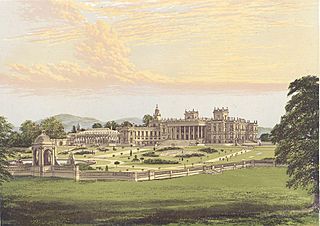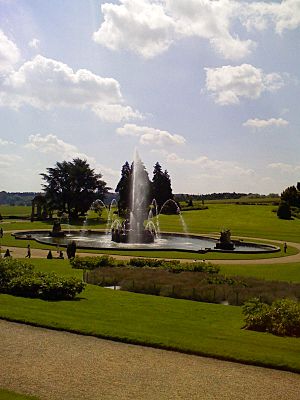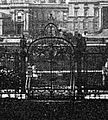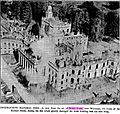Witley Court facts for kids
Quick facts for kids Witley Court |
|
|---|---|
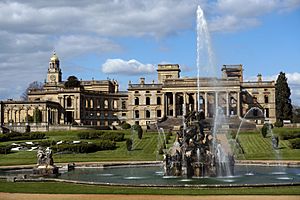
Witley Court and the Perseus and Andromeda Fountain
|
|
| Type | House |
| Location | Great Witley, Worcestershire, England |
| Architect | John Nash, Samuel Daukes |
| Architectural style(s) | Italianate |
| Governing body | Historic England |
|
Listed Building – Grade I
|
|
| Official name: Witley Court and Link to Church of St Michael, Great Witley | |
| Designated | 12 November 1951 |
| Reference no. | 1082656 |
| Lua error in Module:Location_map at line 420: attempt to index field 'wikibase' (a nil value). | |
Witley Court is a grand old house in Great Witley, Worcestershire, England. Today, it's a beautiful ruin, but it was once a huge and fancy mansion. It was first built in the 1600s for the Foley family. Later, in the 1800s, a famous architect named John Nash made it much bigger for Thomas Foley, 3rd Baron Foley.
The estate was then sold to the Earls of Dudley. They hired another architect, Samuel Daukes, to rebuild it again. They turned it into one of the most amazing palaces of the Victorian and Edwardian eras.
After the First World War, the Dudley family's money ran low, and they sold Witley Court. In 1937, a big fire badly damaged the house. After the fire, the estate was broken up and sold off. The house was stripped of everything valuable inside. For 40 years, it just decayed.
In 1972, the government's Department of the Environment (now Historic England) took over Witley Court. Since then, a lot of work has been done to restore and protect it. It is now a spectacular ruin that you can visit.
Witley Court and the nearby Church of St Michael and All Angels are both listed as Grade I buildings. This means they are very important historical sites.
Contents
The Story of Witley Court
Early Days: 1500s to 1700s

The very first building on this spot was a brick house from the 1600s, built by the Russell family. After the Civil War, the house was sold to Thomas Foley (1616-1677), who was a successful iron maker. He added two towers to the house. His grandson, Thomas Foley, 1st Baron Foley (1716–1777), then added wings that created a courtyard at the entrance.
In 1735, Thomas Foley, 2nd Baron Foley (1742–1793) built a new church next to the house. This church got a beautiful baroque style inside in 1747. This happened when he bought paintings and furniture from another grand house called Cannons House. The church's inside included painted panels by Antonio Bellucci and ten hand-painted windows by Joshua Price.
In the late 1700s, the park around the house was redesigned. This even meant moving the village of Great Witley further away from the house! Around 1805, Thomas Foley, 3rd Baron Foley hired the famous architect John Nash. Nash added huge, fancy porches with Ionic columns to the front and back of the house.
The Dudley Family Era: 1800s
In 1837, the Foley family had serious money problems. They had to sell Witley Court to William Ward, who later became the 1st Earl of Dudley. He had inherited a huge fortune from the coal and iron industries.
From 1843 to 1846, Witley Court was loaned to Queen Adelaide. She was the wife of King William IV. She lived at Witley Court for a few years.
In the 1850s, the 1st Earl of Dudley hired architect Samuel Daukes to completely change the house. Daukes covered the old red brick with fancy stone and created very lavish rooms inside. He also hired a garden designer, William Andrews Nesfield, to transform the gardens.
In 1885, the 1st Earl of Dudley passed away. His son, William Humble Ward, 2nd Earl of Dudley, inherited the property. His wife was Rachel Ward, Countess of Dudley.
The Fire and After: 1900s to Today
In 1920, the 2nd Earl sold Witley Court to Sir Herbert Smith, a carpet maker from Kidderminster. Sir Herbert didn't keep many staff to look after the house, and many parts were left empty.
A huge accidental fire started in September 1937. Sir Herbert was away at another house at the time. The fire began in the bakery in the basement. The staff tried to put it out with an old fire pump connected to the fountain, but it didn't work because it hadn't been looked after. Even though only one part of the house was completely burned, the insurance company refused to pay for the huge damage. So, Sir Herbert decided to sell the property.
The estate was split up and sold in pieces. Scrap dealers bought the house itself. They took out everything valuable, leaving it an empty shell. In 1972, the government took over the remains of the house and garden.
Today, the ruins are still amazing to see. English Heritage now looks after the property. The Church of St Michael and All Angels, which is next to the ruins, was lucky and survived the fire.
In 2003, the family who owned the land put the property up for sale on eBay! It was later sold in 2008.
Witley Court has also appeared in pop culture. In 1967, the band Procol Harum filmed their music video for "A Whiter Shade of Pale" at the completely ruined site. The ruins were also seen in the 2016 TV show Close to the Enemy.
House Design
The first house on the site was a medieval building. This was replaced by a brick mansion in the mid-1600s. The Foley family, who bought the estate in 1655, made the house much bigger over the next 150 years.
In the early 1800s, John Nash designed the huge porches on the north and south sides. The final big change to the mansion was done by Samuel Daukes for the Ward family in the mid-1800s. He covered the house in special stone and created very fancy rooms inside, in a style inspired by the French Renaissance.
Gardens and Amazing Fountains
Two enormous fountains at Witley Court survived the fire and the stripping of the house. They were designed by Nesfield and built by James Forsyth and William Forsyth.
The biggest one, the Perseus and Andromeda Fountain, has been fixed and now works again thanks to English Heritage. You can see it working at certain times (check the English Heritage website). You can also still see parts of Nesfield's beautiful formal gardens.
The original plans for the formal gardens have been found, and they are slowly being restored. The main part, called the South Parterre, between the house and the Perseus and Andromeda fountain, is already finished. Work is still ongoing on the East Parterre area.
Images for kids
-
These gates still exist and are now the entrance to the London Bridge site in Lake Havasu City, Arizona in the USA
-
Georgina, Countess of Dudley, wife of the 1st Earl of Dudley.
-
William Humble Ward, 2nd Earl of Dudley who inherited Witley Court when his father died in 1885
-
Rachel, Countess of Dudley, wife of the 2nd Earl of Dudley.
-
Garden Party in front of the Perseus and Andromeda fountain circa 1900. The Countess of Dudley is seated in the center; her daughter, Edith, is in the boat; her daughter, Lady Mackenzie is 2nd from right; the Marquess of Bath is 5th from right, and next to him Violet Mordaunt (daughter of Harriet Mordaunt and later Marchioness of Bath).
-
A carriage outside Witley Court circa 1900. The couple on the far side are the 2nd Earl of Dudley and his wife Rachel.
-
Shooting party at Witley Court in 1894. The Prince of Wales is in the centre of the photo. The couple to the left of him are the Countess of Dudley (with the fur collar) and the 2nd Earl of Dudley (with the white cap)


